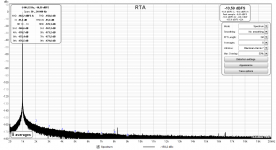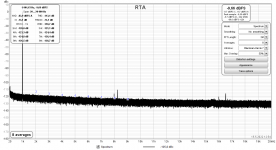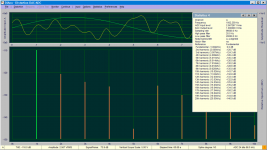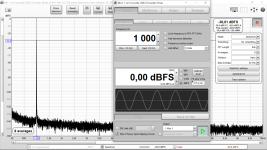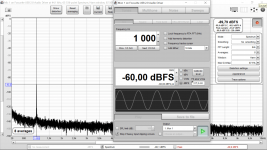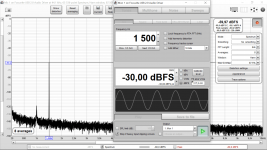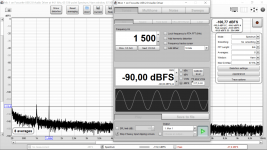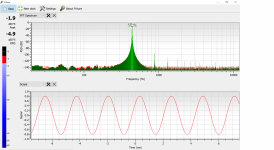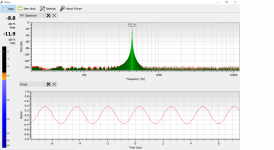I agree that for "bragging rights" the oscillator+notch+LNA+THD compensations scheme works fine. But it is not very flexible for audio measurements.
After some time when I have re-checked and re-calibrated my equipment so here are the new results with Victor's 1kHz oscillator + Twin-T notch 1kHz + LNA (OPA1656 with SE to Balance conversion) + Focusrite Forte as ADC.
Again, the first pic is with notch SW file compensation and second one without (Twin-T has -51 dB attenuation on 1kHz, -8,7 dB on 2kHz, -4,6 dB on 3kHz).
Therefore 2nd harm. is -118-51+9= -160 dB, 3rd harm. is -119-51+5= -165 dB (hidden in noise...).
LNA has +32 dB gain, Forte has +20 dB gain, so +52 dB total.
Now THD is around -157/-158 dB (0,000 0014 %)!
It seems that Victor's oscillator is really a low distortion source.
Martin
P.S.: The third pic is from Diana SW - the same configuration as above without SW file compensation (harmonics are a bit lower)
Again, the first pic is with notch SW file compensation and second one without (Twin-T has -51 dB attenuation on 1kHz, -8,7 dB on 2kHz, -4,6 dB on 3kHz).
Therefore 2nd harm. is -118-51+9= -160 dB, 3rd harm. is -119-51+5= -165 dB (hidden in noise...).
LNA has +32 dB gain, Forte has +20 dB gain, so +52 dB total.
Now THD is around -157/-158 dB (0,000 0014 %)!
It seems that Victor's oscillator is really a low distortion source.
Martin
P.S.: The third pic is from Diana SW - the same configuration as above without SW file compensation (harmonics are a bit lower)
Attachments
Can you repeat the measurements with a marker at -60 dB? When measuring a setup like this there are several places where the numbers get hard to manage. I use a non-harmonic oscillator with a 60 dB attenuator , (1meg in series with 1 Ohm) mixed with a 600 Ohm resistor with the Victor. Your Victor may have a different output impedance. You could easily justify 2 60 dB attenuators in series. There is an issue of leakage around them that will bedevil your efforts if you are not careful.
There is a way to create and use a correction file with Diana.
There is a way to create and use a correction file with Diana.
I'm skeptical of these distortion measurements that show one or two orders of magnitude lower distortion than what the op-amps used are actually capable of on their own merits.
Sure, I will try it later when time allows. I think for 60 dB attenuator should be 1 MOhm + 1 kOhm (with 1 Ohm it is 120 dB).Can you repeat the measurements with a marker at -60 dB? When measuring a setup like this there are several places where the numbers get hard to manage. I use a non-harmonic oscillator with a 60 dB attenuator , (1meg in series with 1 Ohm) mixed with a 600 Ohm resistor with the Victor. Your Victor may have a different output impedance. You could easily justify 2 60 dB attenuators in series. There is an issue of leakage around them that will bedevil your efforts if you are not careful.
There is a way to create and use a correction file with Diana.
Regarding Diana correction file I know about it but did not have time to do so.
Thank you for your help.
Martin
You are right about the divider ratio. Brain fart.Sure, I will try it later when time allows. I think for 60 dB attenuator should be 1 MOhm + 1 kOhm (with 1 Ohm it is 120 dB).
Regarding Diana correction file I know about it but did not have time to do so.
Thank you for your help.
Martin
[...]
Regarding Diana correction file I know about it but did not have time to do so.
[...]
Martin
Hi Martin,
"did not have time"? Just one click: Switch on the correction by means of simulation.
(only valid in case of a classic twin T filter).
Cheers, E.
🙂Hi Martin,
"did not have time"? Just one click: Switch on the correction by means of simulation.
(only valid in case of a classic twin T filter).
Cheers, E.
You know, lot of ideas but less time to make them true...
Martin
That sometimes surprises me too. Even the resistance noise should be much higher.I'm skeptical of these distortion measurements that show one or two orders of magnitude lower distortion than what the op-amps used are actually capable of on their own merits.
From the OPA1656 data sheet:I'm skeptical of these distortion measurements that show one or two orders of magnitude lower distortion than what the op-amps used are actually capable of on their own merits.
Now a plot for 1k and 500R would still be very good.From the OPA1656 data sheet:
View attachment 1054674
If I use four 9V batteries with two diode bucks in series for the power supply, will there be a negative effect on the oscillator?
The OP can work at ±18V, but I found brand new 9V batteries to go up to 9.5V+.
so...is it feasible to simply connect two diodes in series to step down? Could the dynamic voltage drop variation of the diode be a problem?
The OP can work at ±18V, but I found brand new 9V batteries to go up to 9.5V+.
so...is it feasible to simply connect two diodes in series to step down? Could the dynamic voltage drop variation of the diode be a problem?
No problem. The OP can withstand up to +-20V.If I use four 9V batteries with two diode bucks in series for the power supply, will there be a negative effect on the oscillator?
The OP can work at ±18V, but I found brand new 9V batteries to go up to 9.5V+.
so...is it feasible to simply connect two diodes in series to step down? Could the dynamic voltage drop variation of the diode be a problem?
I made a "proof of the concept" withe Forte DAC instead of the passive attenuator (what you recommended) I used REW generator.Can you repeat the measurements with a marker at -60 dB? When measuring a setup like this there are several places where the numbers get hard to manage. I use a non-harmonic oscillator with a 60 dB attenuator , (1meg in series with 1 Ohm) mixed with a 600 Ohm resistor with the Victor. Your Victor may have a different output impedance. You could easily justify 2 60 dB attenuators in series. There is an issue of leakage around them that will bedevil your efforts if you are not careful.
There is a way to create and use a correction file with Diana.
So same gear as before (Twin-T 1kHz notch, 32 dB LNA, 20 dB on Forte gain, REW with notch compensation file) but Vic oscillator was substituted by Forte DAC and REW generator:
- 1st pic is maximum signal 1 kHz what I can use with Forte via USB powering (circa 317 mVrms SE output) with few dB lowered on Forte driver to -30 dB on the scale for easy reading (0 dB REW generator),
- 2nd pic is signal -90 dB 1 kHz on the scale (-60 dB REW generator),
- 3nd pic is signal -60 dB 1,5 kHz on the scale (-30 dB REW generator),
- 4th pic is signal -120 dB 1,5 kHz on the scale (-90 dB REW generator).
I hope this is good example that it works as predicted.
Martin
P.S.: I had some problem with combining Vic oscillator with passive attenuator "injection marker" due to the low output impedance - my oscillator has 100 ohm and always found imbalance with my combinations.
Attachments
Last edited:
THD=-150db were confirmed in the Victor's OSC review 😉
https://archimago.blogspot.com/2022/05/musings-hunt-for-150db-thd-with-victors.html
https://archimago.blogspot.com/2022/05/musings-hunt-for-150db-thd-with-victors.html
I don't know if the ADC is even 24bits real-resolution, I guess 32bit real-resolution ADC will never be released.
And yes, Victor's OSC is Ok to test any ADC, I mean THD is Ok, but not THD+N because that OSC is too noisy.
And yes, Victor's OSC is Ok to test any ADC, I mean THD is Ok, but not THD+N because that OSC is too noisy.
Last edited:
There are a handful of real 24 bit ADC's. None of which are audio. Probably the best ADC is the Keysight 3458 but its fastest sample rate at its highest resolution (8 1/2 digits) is 6 per second, however it's a real 24 bits.
When looking at THD+noise its hard to separate the source noise from the analyzer's noise. Most commercial analyzers are in the 3-4 nV/rtHz range, limited by the input protection and attenuators. Victors oscillator probably has several noise limitations, starting with the timing circuit. However reducing the R for lower noise may increase the distortion due to the additional drive needed. The other option is higher output, the noise is constant and the signal goes up. There are limits to this as well but I am running a KH4400 with +/- 24V supplies and getting 10V at very low distortion at noise from it. A 50 Ohm output also helps lower the noise. The Shibasoku also runs +/-30V rails to get 10V and really low distortion. But its 600 Ohm source limits the noise floor to around 2.5 to 3 nV/rtHz.
When looking at THD+noise its hard to separate the source noise from the analyzer's noise. Most commercial analyzers are in the 3-4 nV/rtHz range, limited by the input protection and attenuators. Victors oscillator probably has several noise limitations, starting with the timing circuit. However reducing the R for lower noise may increase the distortion due to the additional drive needed. The other option is higher output, the noise is constant and the signal goes up. There are limits to this as well but I am running a KH4400 with +/- 24V supplies and getting 10V at very low distortion at noise from it. A 50 Ohm output also helps lower the noise. The Shibasoku also runs +/-30V rails to get 10V and really low distortion. But its 600 Ohm source limits the noise floor to around 2.5 to 3 nV/rtHz.
Hello,
To add two measurements of the "janascard", mine is at 440Hz.
Done with MOTU M2 and E1DA COSMOS ADC ("out of the box" no mono mode, just input set for 2.7V). 16384 points for FFT.
I'm a noob but janascard + cosmos ADC looks really good for the price !
To add two measurements of the "janascard", mine is at 440Hz.
Done with MOTU M2 and E1DA COSMOS ADC ("out of the box" no mono mode, just input set for 2.7V). 16384 points for FFT.
I'm a noob but janascard + cosmos ADC looks really good for the price !
Attachments
If you bought Cosmos ADC for the measurement and you already had Motu, you did spend money far not optimal. Cosmos APU +any "just Ok" ADC 100% outperforms Cosmos ADC.Hello,
To add two measurements of the "janascard", mine is at 440Hz.
Done with MOTU M2 and E1DA COSMOS ADC ("out of the box" no mono mode, just input set for 2.7V). 16384 points for FFT.
I'm a noob but janascard + cosmos ADC looks really good for the price !
- Home
- Design & Build
- Equipment & Tools
- Low-distortion Audio-range Oscillator
